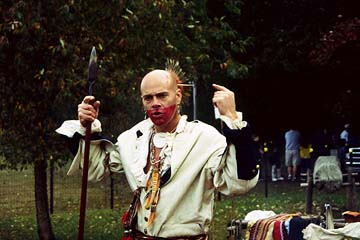Phoebe Farris
E-mail
The dominant images of Native Americans, past and present, tend to focus on two geographical/culture areas, the Plains and the Southwest. These images become fixed in the American media as "typical" physical cultural characteristics. Native American images east of the Mississippi River are often ignored.
These concerns have led me to use photography as a means of documenting various aspects of Native American culture found in the eastern United States and in the Caribbean. I am especially interested in those nations on the Atlantic Coast who had early contact with Europeans, Africans, and "free people of color" ( a broad category usually including, for lack of better terms, mulattoes or racially mixed nonwhites) and absorbed aspects of those outside cultures while still maintaining a firm Native American identity.
Since the late 80's most of my art exhibits and slide presentations have dealt with my documentation of contemporary Native American culture east of the Mississippi River and in the Caribbean. I have traveled to powwows and other cultural events, interacting with relatives, friends, and the public at the Rankokus Powhatan-Renape reservation in New Jersey, the Pamunkey and Mattaponi Reservations in Virginia, the Haliwa-Saponi Cultural Center in North Carolina, the Shinnecock Reservation in Long Island, Pembroke State University in North Carolina (founded and operated by the Lumbee Tribe until taken over by the state), the Piscateway campground in Maryland, and the urban American Indian Community House Art Gallery in New York city.
Photos at these events with people dressed in both regalia and everyday attire reveal the diversity prevalent among eastern tribes. The regalia that I photograph shows a blend of the Plains Indian Pan-Indian styles and also more tribally specific clothing such as the turkey feather headdresses worn by Powhatan chiefs that stand straight up rather than fan out like Plains Indian eagle headdresses.
Also, as part of this series, is photo documentation of reconstructed colonial Native American villages on the Pamunkey Reservation and the Rankokus Powhatan-Renape Reservation. Photographs show the various stages of building traditional homes with willow branches, tree barks, and shrubbery. These houses resemble Iroquois long houses in architectural style but were built smaller to accommodate a single family. Photos of the largest grouping, in a wooded setting in New Jersey, have a timeless quality, with only the color photography to remind the viewer that they are contemporary images.
Straight documentary photography of these
various indigenous people and their cultures as they exist in contemporary
society is the best way that I can use my art to reaffirm a native heritage
that Euro-Americans claim is "extinct" or just a "remnant"
culture. Although many of us were forced to give up our traditional languages
and spiritual belief systems, our cultures still thrive through the arts,
land bases in state-recognized reservations, and participation in Pan-Indian
events.
AHO
